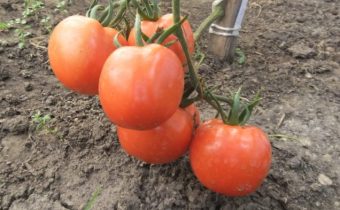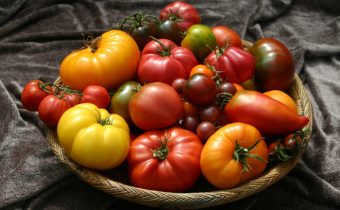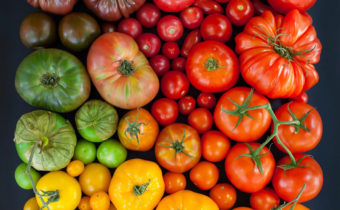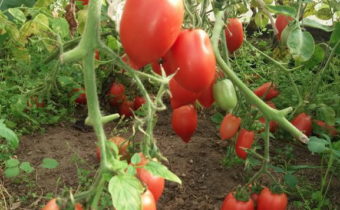Tomato "Yellow giant": sweet with long-term fruiting
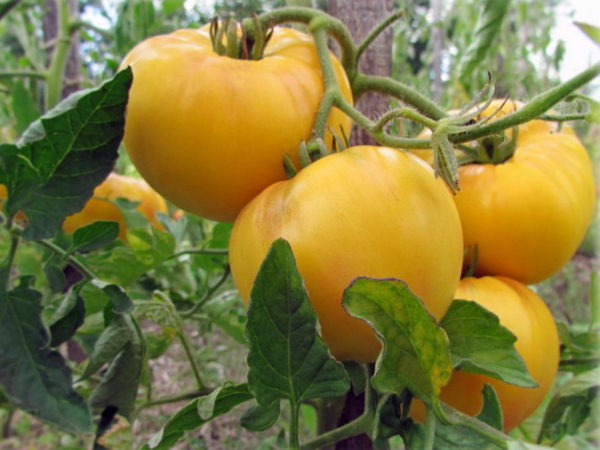
If you are trying to pick up an original variety of tomatoes for your summer cottage or backyard plot, we recommend you to pay attention to the Yellow Giant tomato, description, reviews, photos, which yield is given in this article. Tomatoes of this variety will be large, sweet and have a good yield. Almost all the warm season of the year tasty and large fruits of tomatoes will delight you and your guests.
Characteristic and description
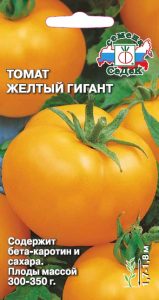 A large and juicy tomato. The yellow giant was bred by the breeders of the Sedek seed agrofirm. When breeding a variety, the specialists set the task to obtain a variety with large fruits of salad type and excellent taste. I must admit that they did it. This variety want to grow on their plots, many domestic gardeners.
A large and juicy tomato. The yellow giant was bred by the breeders of the Sedek seed agrofirm. When breeding a variety, the specialists set the task to obtain a variety with large fruits of salad type and excellent taste. I must admit that they did it. This variety want to grow on their plots, many domestic gardeners.
In Mediterranean countries, yellow tomatoes are golden apples. The name of these solar tomatoes is fully justified. The yellow color of the fruit of this class is affected by provitamin A.
Description of the bush
The tomato bush of this variety is represented by a tall, indeterminate plant, its whip does not end with a flower brush and can grow continuously. The height of the bushes can be 1.2 - 1.7 meters.
Description of the fetus
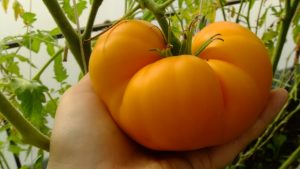 The variety of tomatoes The yellow giant is capable of forming a large number of tasty fruits with the following characteristics over a fairly long period of fruiting:
The variety of tomatoes The yellow giant is capable of forming a large number of tasty fruits with the following characteristics over a fairly long period of fruiting:
- fruits have a bright yellow color;
- the weight of the fruit corresponds to the name of the variety, one tomato, with the observance of technology, can have a mass of up to 400 grams;
- tomatoes contain a lot of sugars, so sweet to the taste; fruit shape is rounded, slightly flattened;
- on maturity the variety is mid-season.
Productivity and quality
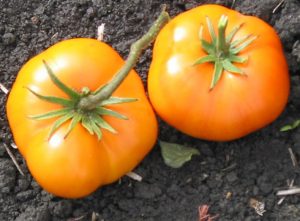 This variety belongs to the middle ripening. From the moment of emergence and until the beginning of fruiting, it usually passes from 110 to 122 days. Tomato Yellow Giant, the characteristics and description of the variety of which are given in this article, is distinguished by a long period of fruiting and a rather high yield. A good agrotechnical background from each bush can result in a total of 5.5 kg of tomatoes of medium and large size.
This variety belongs to the middle ripening. From the moment of emergence and until the beginning of fruiting, it usually passes from 110 to 122 days. Tomato Yellow Giant, the characteristics and description of the variety of which are given in this article, is distinguished by a long period of fruiting and a rather high yield. A good agrotechnical background from each bush can result in a total of 5.5 kg of tomatoes of medium and large size.
Tomatoes of this variety are designed for long-term storage and transportation over long distances. The harvest is recommended to use for its intended purpose within 1 to 2 weeks.
Purpose
As already mentioned, tomatoes of this variety are not intended for long storage. Yes, it is actually not necessary, since the period of fruiting at the Yellow Giant is extended, which allows you to consume fresh fruit until late autumn.
It is conditionally suitable for canning, but given the impressive size of the fruit, this can only be done by slicing them and placing them in jars.
See also: New varieties of tomatoes of the Siberian selection for 2018
Advantages and disadvantages
 This variety is endowed with some advantages, but also has its drawbacks. From the positive qualities of the yellow giant should be highlighted:
This variety is endowed with some advantages, but also has its drawbacks. From the positive qualities of the yellow giant should be highlighted:
- good yield, one bush can produce up to 5.5 kg of fruits;
- fruiting lasts at least 1.5 months;
- large mass of tomatoes, one fruit can reach 400 g;
- the variety has a beautiful fruit shape;
- excellent fruit flavor;
- in content of vitamins surpass all other types of tomatoes;
- tomatoes of this variety contain niacin, which strengthens blood vessels;
- the pulp of tomatoes is saturated with carotene;
- yellow tomatoes have more lycopene enzyme than red tomatoes;
- yellow fruits of this variety are completely safe for allergy sufferers;
- yellow tomatoes contain less calories and are less acidic than red ones, so they are useful for people on a diet;
- yellow tomatoes contribute to the breakdown of fats and accelerate metabolism;
- Yellow giant variety resistant to cracking of fruits.
Regular consumption of tomatoes of this variety is equally useful for people of all ages. Its pulp has a positive effect on the kidneys, liver and the entire gastrointestinal tract.
And, nevertheless, this variety has a number of disadvantages:
- too large fruits that hinder pickling, pickling and canning of tomatoes;
- poor resistance to diseases and pests;
- a bush that is too tall and takes up a lot of space and requires a support or garter
Features of growing varieties
Tomatoes Yellow giant with the same success grown in open ground and in the greenhouse. The main difference here is that the bushes in the greenhouse will be longer and the ripening period will be slightly reduced.
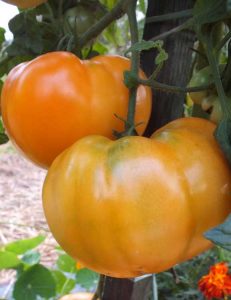 This variety does not impose increased requirements for growing conditions. During the growing season it should be watered as needed, remove weeds from the row spacing, loosen the ground and make several dressings. When forming a bush, you should leave 2 stems and regularly carry out the beefing.
This variety does not impose increased requirements for growing conditions. During the growing season it should be watered as needed, remove weeds from the row spacing, loosen the ground and make several dressings. When forming a bush, you should leave 2 stems and regularly carry out the beefing.
Recommended growing regions
Tomatoes The yellow giant is distinguished by high plasticity and can grow and bear fruit in many regions of the country, with the exception of areas of the far north. Today, the variety is zoned in central Russia, in the Urals in the Volga region and in the south of the country. It is in the southern regions, where there is a lot of sun and heat, the variety shows the highest yield.
Disease and Pest Resistance
In the presence of a large number of positive qualities, the variety is not resistant to diseases and pests. If you do not carry out protective preventive treatments with fungicides, tomato bushes of this variety may be affected by such diseases as:
- late blight;
- tobacco mosaic;
- Alternaria;
- perinospora;
- clasporiosis
Of the pests should be noted Colorado potato beetle. He, as a rule, does not harm adult plants, but the seedlings of tomatoes can spoil. Under greenhouse growing conditions, whitefly, aphids and thrips can cause great harm to tomatoes.
Growing seedlings
By growing seedlings tomato Yellow Giant should start 2 months before the proposed landing on a permanent place. This usually coincides with the last week of February.
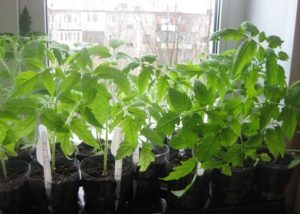 Before sowing, seeds must be treated with fertilizers. To do this, acquire liquid fertilizer "Effecton", nitrophoska or use wood ash. Seeds are soaked in fertilizer solution for 1 day, then they are removed, dried and placed in a refrigerator for 2 days for hardening. After that, the seeds are ready for planting.
Before sowing, seeds must be treated with fertilizers. To do this, acquire liquid fertilizer "Effecton", nitrophoska or use wood ash. Seeds are soaked in fertilizer solution for 1 day, then they are removed, dried and placed in a refrigerator for 2 days for hardening. After that, the seeds are ready for planting.
See also: Tomato "Pink king (king) f1": excellent taste guaranteed
Soil for seedlings should be prepared according to a special recipe and contain:
- peat soil;
- rotted manure;
- turf.
For every 10 kg of prepared soil, add 1 teaspoonful of superphosphate, potassium sulfate and urea. All ingredients are well mixed and filled with this soil capacity for seedlings.
Before sowing, the soil in containers is moderately moisturized and leveled. Then make grooves for sowing a depth of 1 cm. Sowing is carried out according to the scheme of 6 cm by 2 cm. The top grooves are covered with a layer of soil mixture. Additionally, it is not necessary to water the soil.
10-12 days after germination, tomatoes are picked in another container and the plants are provided with a larger area of nutrition.
Transplant into the ground
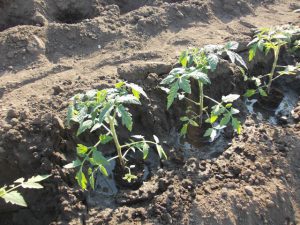 The soil for planting tomatoes Yellow giant should be prepared in the fall. Soil plowed and fertilized. As a fertilizer make rotted manure in a dose of 4 kg per square meter. meter. The same amount of organic matter is added in the spring, adding 1 tbsp to each meter of plantings. spoon of potassium chloride and superphosphate.
The soil for planting tomatoes Yellow giant should be prepared in the fall. Soil plowed and fertilized. As a fertilizer make rotted manure in a dose of 4 kg per square meter. meter. The same amount of organic matter is added in the spring, adding 1 tbsp to each meter of plantings. spoon of potassium chloride and superphosphate.
Transplantation of tomatoes into open ground is carried out when the seedlings turn 50-55 days, usually it happens in the middle - the end of May. To protect seedlings from fungal diseases, preventive spraying of plants with copper chlorine is done. For this, bred 1 tbsp. spoon of the drug in 1 liter of water. The planting scheme of tomatoes should be 60 cm by 20 cm.
Care
The tomato is a yellow giant in the process of growth and development of the bush needs to be staved. It is necessary to form a plant in 2 stalks, removing all the extra stepchildren. 1.5 months before the end of the growing season, it is necessary to pinch all points of growth in order to direct all the nutrients to the formation of fruits.
To obtain a decent harvest during the summer period, it is necessary to feed tomatoes three times.
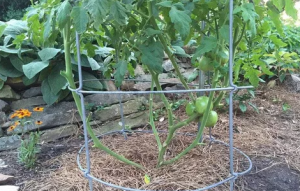
- The first feeding start 10-15 days after transplanting. To do this, prepare a talker of 1 kg of bird droppings (cow manure) and 10 liters of water. It is also allowed to apply a ready-to-use fertilizer such as “Humisol” or “Vermistim”.
- The second dressing is carried out 10 days after the fruit on the second hand began to set. A mixture of fertilizers from 1 kg of bird droppings, “Mortar” fertilizers, copper sulfate and potassium permanganate taken in 3 g per 10 liters of water is applied under the root. Under each bush tomato poured 2 liters of nutrient solution.
- The last feeding of tomatoes is carried out simultaneously with the beginning of fruiting with the same nutrient solution as the second time. Under each bush, you can pour a 2.5 liter mixture of fertilizers.
After each feeding, it is desirable to mulch the soil with a thin layer of soil consisting of sawdust, chopped straw or pine needles. This agricultural application will retain moisture in the soil and prevents weed germination.
In the process of the growing season of tomatoes, you must also observe the irrigation regime and deal with weeds.
See also: Light day for tomato seedlings
So, is it worth choosing a yellow giant for planting? We are sure that this is a good choice, worthy of a professional. Large and tasty fruits, excellent presentation, good harvest, the ability to harvest their own seeds for planting next year - unless this is not enough to make the right choice.
Video: Tomatoes - from sowing to harvest


